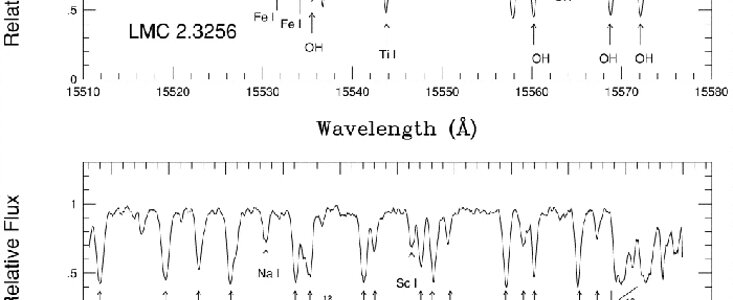Probing the Chemistry of Red Giants in the Large Magellanic Cloud with PHOENIX on Gemini South
2 Diciembre 2002
The Large Magellanic Cloud, a small satellite galaxy at a distance of about 50,000 parsecs, is a prime target in which to probe the chemical evolution of stars. Because this galaxy has a different star formation history than our own galaxy, the properties of its stars are different. Variations in galaxy evolution can lead to differences in chemical composition, which result in stars that noticeably differ in the later phases of their evolution. Measuring and understanding these chemical differences help unravel the physics of the complexes processes of nuclear burning and mixing that take place in the red giant and later phases.
Within a given stellar population in a galaxy, chemical evolution is driven primarily by stellar nucleosynthesis, with the dispersal of the processed material back into the galactic interstellar medium (ISM). This heavy-element enrichment over time depends on such processes as star formation history, internal stellar evolution and nucleosynthesis as a function of mass, how stars return their process ejecta back into the ISM, and whether some of the stellar ejecta can be lost from the galaxy by galactic winds.
Comparing the red giants of the Large Magellanic Cloud with those of our galaxy is of obvious value. However, because the red giants within the LMC are faint due to their greater distance, detailed infrared spectroscopy of them has only become possible with the advent of large 8-10 m telescopes like Gemini equipped with high resolution spectrographs.
Using the high resolution infrared spectrometer PHOENIX on Gemini South, Verne V. Smith (University of Texas, El Paso) and a large international team have determined the abundances of the isotopes 12C, 13C, 14N and 16O along with the abundances of Fe, Na, Sc and Ti in 12 red giant stars spanning masses between 1-4 Msun . This range of star masses in the Large Magellanic Cloud is significantly lower than the range studied previously (8-10 Msun). This deeper exploration has been allowed by the unique combination of PHOENIX and the large aperture and fine image quality of the Gemini South Telescope.
The dependence of the ratio of oxygen to iron ([O/Fe]) on the global heavy element content ([Fe/H]) of stars is crucial in establishing star formation histories of stellar populations in differing environments. Oxygen is made during the late stages of evolution of the most massive stars, while iron comes from both massive, core-collapse (high mass) supernovae (SN II) and binary type Ia (low mass) supernovae (SN Ia). Hence, the run of the O/Fe ratio as a function of Fe/H in a stellar system is a measure of the history of SN II to SN Ia rates, and, hence of the star formation history of the LMC.
The iron abundances sampled by Smith and his team in the LMC range from [Fe/H] = -1.1 to -0.3, approximately between 10% and 50% that of our Sun. The team found that the ratios of both [Na/Fe] and [Ti/Fe] are consistently lower than their Galactic values by ~0.1 to -0.5 dex (factors of 1.25 to 3.0) over the metallicity range sampled in the LMC.
The atmospheres of the LMC red giants observed at Gemini all show evidence of the mixing of CN-cycle elements produced in their cores. 14N is enhanced by +0.4 to +0.8 dex (factors of 2.5 to 6) over its estimated initial values, and 12C is decreased by -0.3 to -0.5 dex (factors of 2 to 3). The 12C/13</sup12C/13</sup
These results by Verne Smith and his collaborators are published in the December 2002 issue of The Astronomical Journal, 124, 3241-3254. The other members of the team are Kenneth H. Hinkle (NOAO), Katia Cunha (Observatorio Nacional, Rio de Janeiro), Bertrand Plez (Universite de Montpellier), David L. Lambert (University of Texas at Austin), Catherine Pilachowski (Indiana University), Beatriz Barbuy (Universidade de Sao Paolo), Jorge Melendez (Universidad National de Ingenieria, Lima), Suchitra Balanchandran (University of Maryland), Michael Bessell (Australian National University), Douglas Geisler (Universidad de Concepcion), James Hesser (HIA) and Claudia Winge (Gemini Observatory, La Serena).



![Values of [O/Fe] versus [Fe/H] for the Large Magellanic Clouds red giant stars](/public/media/archives/images/news/geminiann02012b.jpg)